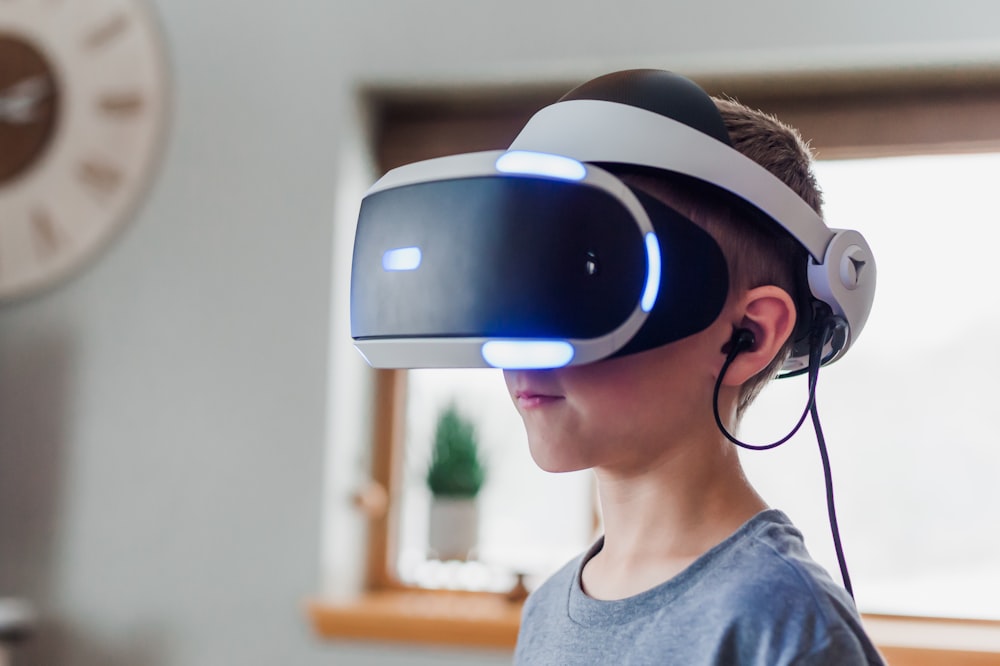The future of entertainment is here with the introduction of Augmented Reality (AR) and Virtual Reality (VR). AR technology overlays digital information on top of what you see in the real world. VR technology transports you to a virtual world that’s created by the software. These technologies are now being used across many industries, from gaming to architecture.
Augmented reality games for example use your smartphone or tablet as a window into an imaginary environment where 3D objects can be added to make it feel like they exist in our world. The game Pokémon Go is one example, but there are plenty more out there which allow kids to explore their neighborhoods while catching virtual monsters at the same time!
Virtual reality technology has also been heavily adopted by companies in the video game industry. Virtual reality is a headset that covers your eyes and ears, blocking out any outside noise to give you a completely immersive experience. PlayStation has released its first Playstation VR back in 2016 and announced the second generation of PlayStation VR is coming on the market soon.
Gaming is just one application of virtual reality, but this technology can now be used by architects to make virtual walk-throughs of their building designs before any construction begins. This can help reduce the number of design errors and also prevent time delays by allowing the client to preview the finished product before acceptance.
Both AR and VR technologies are revolutionizing how we enjoy entertainment, but this technology is not just for gaming and entertainment. It can also be used to train surgeons on how to operate on patients without having the risk of actual surgery. VR technology is also being used for therapy where PTSD sufferers can be safely transported back into their memories which helps them process their feelings in a controlled environment. Not only in the health industry but They are also being used on
How AR and VR shape our ways to consume entertainment
It is just the beginning, these technologies are sure to power many more industries and bring us even closer to a world like a fairytale.
Augmented Reality (AR) and Virtual Reality (VR) are technologies that are quickly changing how we play games, watch movies, interact with our environment, communicate with other people, learn new things, experience art and even perform surgeries.
They shape our ways to consume entertainment. Their implementation in the movie industry, for example, is already being used mostly by directors to create pre-visualization. This allows them to see what the shot will look before it’s been filmed, and as a result, they can make better decisions about how it should be framed and which lenses they should use. AR and VR also allow you to view movies in a 3D format that’s more immersive.
While in the gaming industry their usage is even more massive. For example, “Pokémon Go” is one of the thousands of augmented reality games where players use their mobile devices to interact with the game. Virtual reality, on the other hand, is a more immersive approach where players wear headsets that are capable of stereoscopic 3D rendering.
They also improve our gaming experience by adding new features like Virtual Surround Sound. Virtual Surround Sound is an algorithm that uses Head-Related Transfer Function (HRTF) and generates a 3D sound environment around the player. HRTF is complex enough to create complex spatialization; it simulates how real sounds interact with different parts of your ears as they come from designated directions, including distance and intensity.
Interestingly enough, these techs will also affect other gaming industries like online casino gaming. Casino operators are investing in technology that creates an enriched player experience on digital casino tables. When playing online roulette, for example, you can expect to have the same visual cues that would be found on a traditional table game. Online casinos will also benefit from this technology by providing players with information about their favorite games by streaming it directly to the smart glasses. It also makes sense if in the future VR can incorporate smart casino guides and clues live on their glasses during the gambling process.
AR and VR will continue to change how we experience entertainment, but whether this technology becomes mainstream or not is still unclear. The future of AR/VR can be seen in various industries that are part of our daily life. It’s just the beginning, these technologies.
***
The future of AR and VR
Although the makers of both tend to agree that ‘AR’ will be more prominent as a term, many use terms interchangeably because they are similar in nature and application. AR is typically used to describe anything that superimposes virtual information over real-world objects, while VR creates entire worlds separate from the one we live in. Many equate the two with entertainment purposes, but today’s technologies have also found practical applications in fields ranging from education to military training.
Even though virtual reality is often associated with gaming, it has practical real-world applications that are being developed every day.
The future of these technologies is promising, but there are still many challenges that need to be overcome before they can become widely used.
One of the challenges is the lack of social presence.
The majority of virtual reality experiences are done alone, with the person wearing the VR device isolated from others. This is because current VR devices can only really immerse one person at a time, and this limits their ability to be used in schools or other social settings.
By its very nature, augmented reality requires the real world to be there for it to work. It can’t create a virtual object that isn’t anchored in reality but instead must superimpose information on top of existing objects. Right now, AR exists primarily as smartphone apps that provide extra information about the things you see through your phone’s camera.
The next challenge is limited content
Content is what makes technology useful. Without compelling content, AR and VR are too gimmicky to be very productive. Few people want to put on a headset or use their phone just to get information that they could otherwise see by looking up from their phone. Developers need time with the technologies before they can start creating truly immersive experiences.
The most significant challenge is a high cost
AR and VR technologies aren’t cheap to produce. Even smartphone-based AR is somewhat costly, but current VR headsets can easily run in the thousands of dollars when you add in the computer needed to power them.
It will take time for these costs to come down. Right now consumers aren’t the target market, and it won’t be profitable for companies to produce something that isn’t guaranteed to sell in large quantities.
A promising future
Although there are still challenges to overcome, AR and VR technologies have a promising future. Overtime costs will come down as demand rises, and developers will create more content for people to experience.
Eventually, these technologies will become much more widespread. However, it is likely that they will first find their niche in the market before becoming standard technology. Just as smartphones have replaced normal cell phones for many people, AR and VR technologies may eventually replace our smartphones for everyday use.








